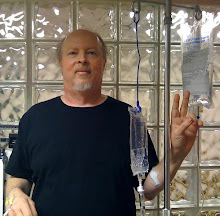My hemoglobin was 15.6, up from 13.0 six weeks before. It had been in the 13s since shortly after I began taking Revlimid (lenalidomide) on March 6, 2010. (Yep, the one-year anniversary approaches. I’m thinking of celebrating with a chocolate cupcake topped with white Revlimid pills as sprinkles.)
It turns out that the last time my hemoglobin was that high was in May 2006. In fact, on the day I was diagnosed with chronic lymphocytic leukemia -– September 3, 2003 -– it was 15.6. The highest it has ever tested out at is 15.8. So something good is happening in hemo-land.

This is especially encouraging since autoimmune hemolytic anemia (AIHA) has been an almost constant drain on my hemoglobin since early 2007. I take this latest result as a further sign that Revlimid has put a stake through its heartless little heart.
Of course, absent AIHA, CLLers also face the challenge of their bone marrow clogging up with CLL cells, with a resulting gradual decline in red cell production. The NCI guidelines define hemoglobin below 10.0 as the welcome mat into Stage 3 CLL and one of the triggers for treatment. Where my hemoglobin would be absent both the Revlimid and my history of AIHA, I haven't a clue. But seeing it at the same place as it was at diagnosis does provide a not-so-cheap thrill. Maybe I'll have two of those cupcakes.
My test also showed higher platelets. Over the course of my CLL history, they have gradually declined. For the last couple of years they have generally been at about 130. The latest test puts them at 160. Platelets can jump for any number of reasons. For example, they can be sequestered in the spleen and treatment can reduce the spleen, forcing them into the bloodstream. In this case, I doubt my spleen has suddenly become smaller.
So the big question is: Is Revlimid having a positive effect in my bone marrow? A 2008 MD Anderson study of Revlimid in 44 relapsed and refractory patients reported that 26% experienced “resolution of bone marrow involvement.” How that was tested for and defined was not described in the paper, but it is encouraging nonetheless. I am also aware of patients who are on the drug for a long time and begin to experience, at a certain point, the “kicking in” of improving numbers.
I’ll have to see if the trend continues on future tests. After all, one test is interesting, two are a trend. But I have no reason the believe the test is wrong. I’ve been napping a lot less recently, even when I’ve had less than eight hours of sleep at night, which would be one result of higher hemoglobin. And not all the numbers are higher, so it’s not like the blood counting machine was ascribing a higher count to everything. (My absolute lymphocyte count remains pretty stable at 6.24.) This test was done at the same lab that I've been using for the past year.
Finally, on the Coumadin (warfarin) update front, my dose has been bumped up slightly. It’s now 4 mg on Monday, Wednesday, and Friday, 2 mg on other days. This came after my PT/INR tests continued to show that I clot faster or the same as normal even though I’m on the blood thinner. My Revlimid dose is now 5 mg five days a week, 10 mg on Wednesday and Sunday. It probably won't go any higher for the foreseeable future.






